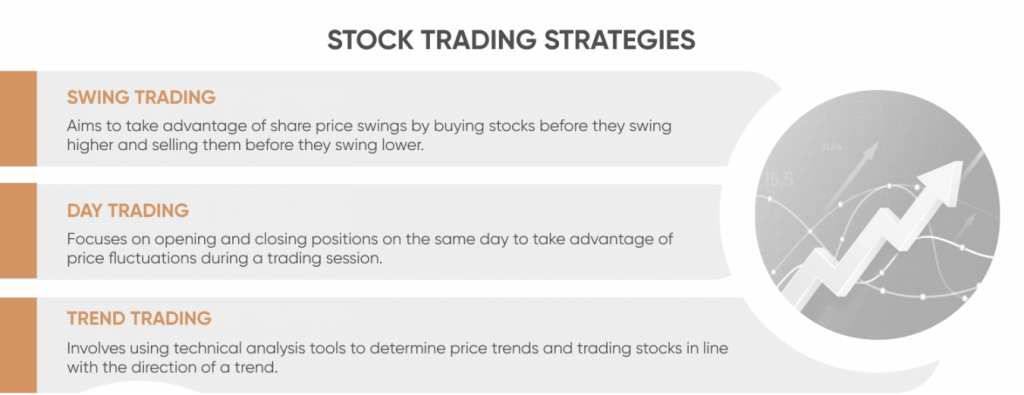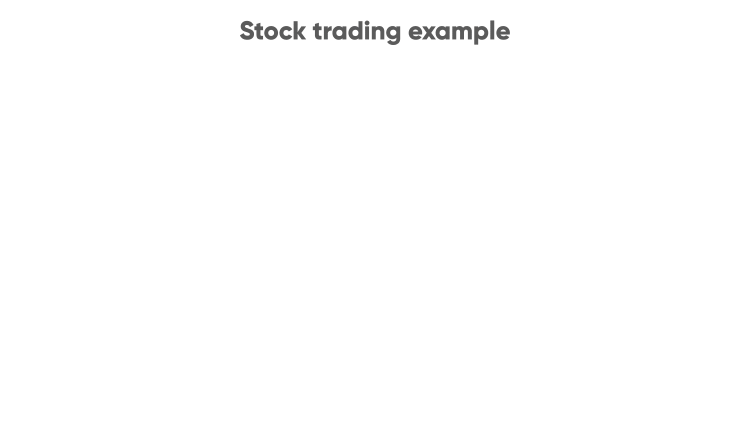Risk-management tools when trading stocks
It’s important to understand how to use risk-management tools like limit-orders, take-profit orders and stop losses to enter positions at the price you want, sell them at a certain level to lock in potential profits, or if the assets you trade fall by a specific amount to avoid further losses.
You may consider diversifying your portfolio so that no single position accounts for a large portion of it to avoid the risk of losing a large part of your money if a particular stock falls.
You could also learn how to use technical analysis tools on price charts. This could help you identify price trends and trading ranges, generating ideas for when to open and close positions.
Keeping a trading diary to understand your successes and failures could also help you learn to trade stocks better in the future.
Different ways to trade stocks: retail trader edition
In addition to real share trading, traders also have other options to consider like trading derivative products of stocks, such as futures or options contracts and CFDs to take positions on stock prices without owning the actual shares.
Derivative products allow exposure to stock markets without owning the underlying asset. In case of stock CFDs, traders can also use leverage, which means both their profits and losses can be magnified.
Real stocks
Real stocks simply means that you are buying shares of an underlying company. You can do so by opening an account on a share-dealing platform.
Owning underlying stocks is suitable for both long-term investing and short-term trading. Some brokers offer fractional shares, which means that you can buy a fraction of a company’s share if the total price is too expensive for you.
CFD trading
Contracts for difference (CFDs) allow traders to use margin to potentially maximise their funds into larger positions and speculate on share price movements without owning the underlying stock. Note that CFDs are leveraged products, which means both profits and losses can be magnified. Keep in mind that buying shares without leverage also carries risk.
How to trade stock CFDs
How does trading stocks work using CFDs? A CFD is a derivative product. A broker typically agrees to pay a trader the difference in the value of a security between an opening and closing price. Traders can open long positions, speculating that the price will rise, or short positions, speculating that the price will fall.
You can sign up for an account with a CFD provider like G Assets LTD to speculate on company stock price fluctuations. Rather than requiring a specific stock trading account, you can trade stock CFDs along with CFDs on commodities, indices and forex in the same trading account.
CFD trading is considered a short-term approach. Traders open and close positions within time frames ranging from a day to a week, but this does not necessarily mean they have to be short-term. Less commonly, CFDs can be held for months at a time, but this incurs additional fees such as overnight fees due to the leverage borrowed.
To trade stock CFDs, follow these steps:
- Create a CFD trading account.
- Choose the stocks you want to take positions on.
- Use your trading strategy to identify potential trades.
- Open your first trade and consider using risk management tools such as stop orders and limit orders as well as take-profit orders.
- Monitor your trade using technical and fundamental analysis tools.
- Close your position based on your trading strategy.
If you are looking to learn how to trade stock CFDs for beginners, you could start by opening a demo account on G Assets LTD so that you can get a feel for the process without putting your money at risk.
Once you are ready to start trading with real money, open a live account and deposit the funds you want to trade with.
Pros and cons of trading stock CFDs
Trading stocks using CFDs comes with several advantages. Unlike buying and selling stocks outright, which requires the share price to go up for you to make a profit, CFDs give you the opportunity to speculate on share prices in both directions. You can trade in both falling and rising markets due to the ability to short-sell CFD products.
CFDs can therefore be used to hedge against existing portfolio holdings. For instance, if you hold a portfolio of shares in a particular sector but expect it to experience a short, sharp dip, you can use CFDs to short-sell your existing shares, hedging against this possibility.
If your expectations are wrong, you have the added bonus of being able to offset any losses incurred with CFDs against the capital gains charged on the increase of your portfolio.
CFDs can be traded on margin. This means a trader only needs to put down a fraction of the value of their trade, borrowing the remaining capital from their broker. This allows for more accessibility and greater exposure. Note that CFDs are leveraged products, which means both profits and losses can be magnified.
The 5% margin offered by G Assets LTD means that you only need to deposit 5% of the value of the trade you want to open, and the rest is covered. For example, if you want to place a trade for $1,000 worth of CFDs, with a 5% margin you will only need $50 of initial capital to open the trade.










